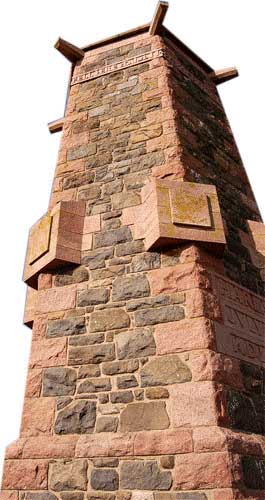THE BATTLE OF HARLAW - 1411 |
 |
A century after it was fought, the Battle of Harlaw was still being re-enacted by youngsters at play, such was its effect on the psyche of the Scottish nation. Arguably, the battle and the events leading up to it were perhaps more keenly felt - and remembered - by the Lowland Scots, those living outside of the Highlands itself. Many a Lowlander saw deliverance from the fierce Highland clans as something akin to, if not greater than, their deliverance from the hands of the English in the Scottish Wars of Independence a century or so before. Donald, Lord of the Isles, declared war on the lowlands because his claims to the Earldom of Ross were rejected by the Earl of Mar, son of the Wolf of Badenoch and nephew of Albany, and the Scottish government. Like his ancestors, some of whom had sided with the English Kings against their own, he hardly regarded the Stuarts as his monarch. With a force of 10,000 men, comprised primarily of the MacLeod, MacDonald, and MacLean clans, he attacked the lowlanders army at Harlaw. The Battle of Harlaw took place near the junction where the waters of the Ury river flow into the much larger River Don, not far from the small village of Harlaw itself, which lies about 20 miles north west of Aberdeen. Harlaw was a major battle by even the bloody standards of the time. It also marked the end of an incursion from Highlands into Lowlands which at times seemed unstoppable, its shock waves threatening the power even of the Scottish monarchy. Donald's advance was met two miles past Inverurie at Harlaw by the townspeople of Aberdeen lead by Sir Robert Davidson, Lord Provost of Aberdeen along with a force of Keiths, Forbes', Leslies and Irvines, led by the Earl of Mar. Although the Earl's army was outnumbered quite drastically, some accounts put the miss-match at maybe ten to one, what it lacked in numbers was more than made up for in the bravery of its commanders, knights and foot soldiers. The army also had that other necessary quality, discipline. |
Both sides faced up to each other, Donald at the head of his men and flanked either side by his various chieftains and their clansmen raring to get at the enemy. Immediately facing them was a relatively small body of knights and soldiers commanded by the constable of Dundee and the sheriff of Angus, with the main body of the Earl's men drawn up behind. The Highland army charged in its usual blood-curdling way, meeting first the body of knights and soldiers at the front who, basically because of their better weaponry and discipline, effectively halted the momentum of the charge. Sir James Scrymgeour and his knights took advantage of the situation and pushed forward, leaving a trail of hundreds of dead and dying Islemen and Highlanders. However, for every Highlander killed, another took his place without hesitation, and Sir James and his men gradually became exhausted, and surrounded. Eventually they all perished.Meanwhile, the Earl of Mar at the head of his men, plunged into the welter of blood, taking the fight to the very heart of the Highland army. But here, too, it proved an uneven contest, although the fighting continued until darkness eventually forced a halt. It had been a costly affair, for both sides, and a day of incredible bravery, shown in equal measure by the men of both sides. It could not be said there was a victor as such, although the Lowlanders by the end of the day were down to a handful of men. Their casualty list was horrendous, with hardly a noble family in the land unaffected in some way. Dead was Sir James, along with Sir Alexander Ogilvy, the sheriff of Angus, and his eldest son George Ogilvy. Sir Robert Davidson, the provost of Aberdeen was amoung the dead along with some 500 men that he'd brought along. Also killed were Sir Thomas Murray, Sir Robert Maule of Panmure, Sir Alexander Irving of Drum, Sir William Abernethy of Salton, and Sir Alexander Straiton of Lauriston. Something in the region of a 1,000 Islesmen and Highlanders also lay dead on the battlefield, with thousands more wounded. Harlaw had been nothing short of a mauling for Donald, forcing him to lick wounds and re-think plans. But he would never recover his lost power or pose a threat ever again to the Scottish Crown. The battle lasted most of the 24th of July until Donald’s men withdrew. The fight was so severe, the conflict became known as the Battle of "Red Harlaw". Sir Robert Davidson led his men to victory but as mentioned had paid with his life. The victory was considered so important, that certain privileges were granted to the heirs of the fallen lowlanders. If Lord Donald had succeeded in defeating this army, the history of Scotland would be a great deal different than the one we know today. |
Our Thanks To THE CLAN DAVIDSON ASSOCIATION For This History Lesson |
 |
© Paisley Tartan Army 2008-09
